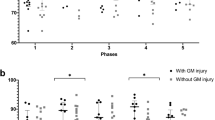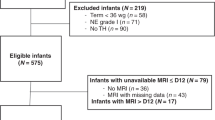Abstract
Objective:
Hypothermia improves clinical outcomes and brain magnetic resonance imaging (MRI) findings in infants with hypoxic–ischemic encephalopathy. We hypothesized that clinical status following hypothermia predicts brain MRI abnormalities, and helps determine which infants need an early MRI evaluation before discharge. The objective of this study was to determine whether the clinical evaluation 1 week after completion of 72 h of hypothermia treatment predicts the presence of brain MRI abnormalities related to hypoxia–ischemia.
Study Design:
The medical records of 83 consecutively cooled infants who underwent brain MRI were reviewed. Clinical evaluation by day 10 of life consisted of assessment of oral feeding ability, spontaneous activity, need for mechanical ventilation and a history of clinical seizures. Logistic regression analysis was performed using all four covariates, with an abnormal MRI as the primary outcome. Brain MRI with lesions in both the basal nuclei and the cortex was considered to be severely abnormal.
Result:
MRI was abnormal in 46 (55%) infants. Univariate analysis identified all of the criteria as being significantly associated with an abnormal MRI. On multivariate analysis, only feeding difficulty (P<0.001, OR 9.5, 95% confidence interval (CI) 3 to 29.8) and a history of clinical seizures (P<0.001, OR 12, 95% CI 3 to 46.5) were significantly associated with an abnormal MRI. The areas under the receiver operating characteristic curve for feeding ability and seizure activity combined (0.86, 95% CI 0.77 to 0.94) indicated good accuracy with respect to the primary outcome. The negative predictive values of feeding difficulty and seizure activity for a severely abnormal MRI were 91% and 96%, respectively.
Conclusion:
Infants who do not have a history of clinical seizures and who attained full oral feeding by 1 week after hypothermia are unlikely to have an abnormal brain MRI. This simple assessment provides significant prognostic information that can be useful in parental counseling, and may allow selective use of pre-discharge MRI.
This is a preview of subscription content, access via your institution
Access options
Subscribe to this journal
Receive 12 print issues and online access
$259.00 per year
only $21.58 per issue
Buy this article
- Purchase on Springer Link
- Instant access to full article PDF
Prices may be subject to local taxes which are calculated during checkout

Similar content being viewed by others
References
Rutherford M, Ramenghi LA, Edwards AD, Brocklehurst P, Halliday H, Levene M et al. Assessment of brain tissue injury after moderate hypothermia in neonates with hypoxic-ischaemic encephalopathy: a nested substudy of a randomised controlled trial. Lancet Neurol 2009; 9: 39–45.
Inder TE, Hunt RW, Morley CJ, Coleman L, Stewart M, Doyle LW et al. Randomized trial of systemic hypothermia selectively protects the cortex on MRI in term hypoxic-ischemic encephalopathy. J Pediatr 2004; 145: 835–837.
Rutherford MA, Azzopardi D, Whitelaw A, Cowan F, Renowden S, Edwards AD et al. Mild hypothermia and the distribution of cerebral lesions in neonates with hypoxic-ischemic encephalopathy. Pediatrics 2005; 116: 1001–1006.
Belet N, Belet U, Incesu L, Uysal S, Ozinal S, Keskin T et al. Hypoxiceischemic encephalopathy: correlation of serial MRI and outcome. Pediatr Neurol 2004; 31: 267–274.
Gluckman PD, Wyatt JS, Azzopardi D, Ballard R, Edwards AD, Ferriero DM et al. Selective head cooling with mild systemic hypothermia after neonatal encephalopathy: multicentre randomised trial. Lancet 2005; 365: 663–670.
Shankaran S, Laptook AR, Ehrenkranz RA, Tyson JE, McDonald SA, Donovan EF et al. Whole-body hypothermia for neonates with hypoxic-ischemic encephalopathy. N Engl J Med 2005; 353: 1574–1584.
Nelson KB, Ellenberg JH . The asymptomatic newborn and risk of cerebral palsy. Am J Dis Child 1987; 141: 1333–1335.
Barkovich AJ, Hajnal BL, Vigneron D, Sola A, Partridge JC, Allen F et al. Prediction of neuromotor outcome in perinatal asphyxia: evaluation of MR scoring systems. Am J Neuroradiol 1998; 19: 143–149.
Sarkar S, Barks JD, Bapuraj JR, Bhagat I, Dechert RE, Schumacher RE et al. Does phenobarbital improve the effectiveness of therapeutic hypothermia in infants with hypoxic-ischemic encephalopathy? J Perinatol 2012; 32: 15–20.
Sarkar S, Donn SM, Bapuraj JR, Bhagat I, Dechert RE, Barks JD . The relationship between clinically identifiable intrapartum sentinel events and short-term outcome after therapeutic hypothermia. J Pediatr 2011; 159: 726–730.
Sarkar S, Donn SM, Bapuraj JR, Bhagat I, Barks JD . Distribution and severity of hypoxic-ischaemic lesions on brain MRI following therapeutic cooling: selective head versus whole body cooling. Arch Dis Child Fetal Neonatal Ed 2012; 97: F335–F339.
Miller SP, Ramaswamy V, Michelson D, Barkovich AJ, Holshouser B, Wycliffe N et al. Patterns of brain injury in term neonatal encephalopathy. J Pediatr 2005; 146: 453–460.
Gunn AJ, Wyatt JS, Whitelaw A, Barks J, Azzopardi D, Ballard R et al. Therapeutic hypothermia changes the prognostic value of clinical evaluation of neonatal encephalopathy. J Pediatr 2008; 152: 55–58.
Miller SP, Latal B, Clark H, Barnwell A, Glidden D, Barkovich AJ et al. Clinical signs predict 30-month neurodevelopmental outcome after neonatal encephalopathy. Am J Obstet Gynecol 2004; 190: 93–99.
Kaufman SA, Miller SP, Ferriero DM, Glidden DH, Barkovich AJ, Partridg JC . Encephalopathy as a predictor of magnetic resonance imaging abnormalities in asphxiated newborns. Pediatr Neurol 2003; 28: 342–346.
Nelson KB, Ellenberg JH . Antecedents of cerebral palsy,: I: univariate analysis of risks. Arch Pediatr Adolesc Med 1985; 139: 1031–1038.
Dixon G, Badawi N, Kurinczuk JJ, Keogh JM, Silburn SR, Zubrick SR et al. Early developmental outcomes after newborn encephalopathy. Pediatrics 2002; 109: 26–33.
Thoresen M . Patient selection and prognostication with hypothermia treatment. Semin Fetal Neonatal Med 2010; 15: 247–252.
Sarnat HB, Sarnat MS . Neonatal encephalopathy following fetal distress: a clinical and electroencephalographic study. Arch Neurol 1976; 33: 696–705.
Shalak LF, Laptook AR, Velaphi SC, Perlman JM . Amplitude-integrated electroencephalography coupled with an early neurologic examination enhances prediction of term infants at risk for persistent encephalopathy. Pediatrics 2003; 111: 351–357.
Ambalavanan N, Carlo WA, Shankaran S, Bann CM, Emrich SL, Higgins RD et al. National Institute of Child Health and Human Development Neonatal Research Network. Predicting outcomes of neonates diagnosed with hypoxemic-ischemic encephalopathy. Pediatrics 2006; 118: 2084–2093.
Author information
Authors and Affiliations
Corresponding author
Ethics declarations
Competing interests
The authors declare no conflict of interest.
Additional information
Author contributions
Each author listed on the manuscript has seen and approved the submission of this version of the manuscript and takes full responsibility for the manuscript. Dr Sarkar wrote the first draft of the manuscript.
Disclaimer
We state that this work is not and will not be submitted to any other journal while under consideration by The Journal of Perinatology.
Rights and permissions
About this article
Cite this article
Sarkar, S., Bhagat, I., Bapuraj, J. et al. Does clinical status 1 week after therapeutic hypothermia predict brain MRI abnormalities?. J Perinatol 33, 538–542 (2013). https://doi.org/10.1038/jp.2013.1
Received:
Revised:
Accepted:
Published:
Issue Date:
DOI: https://doi.org/10.1038/jp.2013.1
Keywords
This article is cited by
-
Brainstem hypoxic–ischemic lesions on MRI in infants treated with therapeutic cooling: effects on the length of stay and mortality
Journal of Perinatology (2021)
-
Predicting the need for home gavage or g-tube feeds in asphyxiated neonates treated with therapeutic hypothermia
Journal of Perinatology (2018)



